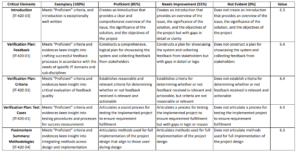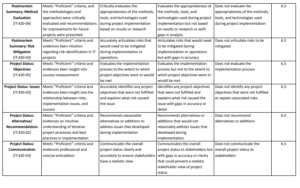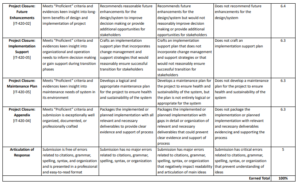Solved: IT 420 Final Project Guidelines and Rubric
The final project for this course is the creation of a project closure document. Information technology (IT) is a field in which practitioners are valued for their ability to plan for and implement solutions. In this course, you will create a project closure document that will include evidence of verification (verification plan) and implementation, or a plan for implementation, based off the design you developed in IT 415 (the prerequisite for this course). Your project closure document, submitted in the form of a report with accompanying documentation, will allow you the opportunity to showcase your ability to translate a design into a real solution to leverage IT. The design and project plan created in IT 415 will be the foundation on which your project closure document should be built. Note that while implementation of your solution design from IT 415 may be helpful in evidencing success in your chosen discipline, there will also be cases in which full implementation is not feasible, not possible given the available tools and environment, or would prove to be unsuccessful given the knowledge obtained during this course. The key to success in this final project does not rest on whether you can fully implement your design. Instead, success will be based on how well you are able to evidence the skills, knowledge, abilities, and dispositions required for successful implementation with the tools and environment available. This means that your explanations of why you cannot implement your project will be just as important as implementation would be. Analysis, communication, strategic planning, research and evidence collection, and many other skills will be emphasized. Regardless of available tools and environments that might limit implementation, the same skills will be needed for planning, predicting, and measuring success. Your deliverables (including those submitted in support of your project closure document) should reflect your best writing and your highest level of competency in IT and should demonstrate that you possess the critical soft skills required to effectively contribute to a business’s organizational environment. The project is divided into two milestones, which will be submitted at various points throughout the course to scaffold learning and ensure quality final submissions. These milestones will be submitted in Modules Three and Five. The final project will be submitted in Module Seven.- In this assignment, you will demonstrate your mastery of the following course outcomes: IT-420-01: Draft plans and criteria for effectively collecting and evaluating feedback that can improve information technology system designs
- IT-420-02: Develop recommendations in support of decision making that capture and illustrate information system enhancements and opportunities
- IT-420-03: Communicate accurately and efficiently to inform project stakeholders of risks, risk mitigation strategies, and information technology project status
- IT-420-04: Plan for the implementation of effective information technology solution designs using appropriate methods, tools, and technologies
- IT-420-05: Develop effective maintenance strategies for given information systems that meet organizational needs and ensure health and sustainability of the system
Prompt
Your project closure document will evidence the skills, knowledge, abilities, and dispositions required of IT professionals within the specific sub-discipline your chosen topic reflects. You should focus on communicating the required information effectively throughout the project closure document. Remember that stakeholders who read your project closure document are not likely to have contributed to the project development and will require additional context and clear communication. Specifically, the following critical elements must be addressed: I. Introduction: Present an overview of the problem that the project addressed, the significance this project has, and objectives that the project should have met. Much of this can be taken from the project proposal submitted in IT 415 but including any necessary alterations or adjustments you made during this course. The aim of this section is to provide context to the rest of the project closure document so that the audience can critically evaluate the completed project and provide feedback. [IT-420-03] II. Verification Plan: A verification plan will provide an organized way to conduct verification of the system, which can be done through execution of formal test cases that exercise the functionality and performance of the system. It can also include obtaining verbal feedback through focus groups, usability testing of prototypes, and other means. The following sections should be included: a) Feedback Plan: Construct a comprehensive plan for showcasing your system and collecting feedback from stakeholders. Explain what you will present as regular artifacts of the system to your stakeholders so you can obtain feedback. The stakeholders from whom you must collect feedback will vary depending on your IT issues. [IT-420-01] b) Criteria: Establish the criteria you will use to determine whether or not feedback received is relevant and actionable. [IT-420-01] c) Test Cases: In this section, you will describe how you will (or would) test the implemented project to ensure it fulfilled all requirements and that the promised objectives/functionality were met. You will be required to fully test your system and supply the test results as part of the appendix of your project closure document, if implementation of your project is possible. [IT-420-01] III. Project Closure a) Postmortem Summary: An important part of IT system development is to capture what worked well and what did not. You should be able to effectively communicate this to stakeholders during a project closure meeting and effectively document this to be referenced as a learning opportunity by other IT developers. 1. Methodologies: Articulate the methods you used, or would use, for full implementation of your project design. These should speak to the methods and techniques identified in your planning stage from IT 415. [IT-420-04] 2. Method Evaluation: Evaluate the appropriateness of the methods, tools, and technologies used during project implementation based on the results or based on research evidence in the event you cannot implement your project. [IT-420-04] 3. Risk Mitigation: Articulate any risks that need to be or would need to be mitigated so that future developers can anticipate these risks in similar projects. [IT-420-03] b) Project Status: In this section, discuss the status of your project. You will describe whether it is fully complete and evaluate the effectiveness of the system design. 1. Objectives: Evaluate whether or not the objectives stated in the original project proposal were met, including those to ensure the design meets organizational/user needs in the long-term. If you cannot implement your proposal, evaluate your implementation plan for its potential to lead to meeting the objectives based on research. [IT-420-05] 2. Issues: Identify any project objectives that were not fulfilled and explain the risks that prevented fulfillment to inform stakeholders of completion risk, mistakes, and so on. [IT-420-03] 3. Alternative/Recommendations: If a shortcut or alternative to the planned design was implemented to allow the project to move forward, describe what this was and whether or not it should be corrected or improved in a future version for development. If you could implement your design without any changes, defend your design in terms of ease, efficiency, and effectiveness. It is unlikely that you will be able to fully implement without adjustment to your design, however, so if you did not make changes, defend your reasoning. In the event you could not implement your design, discuss what limited your process and the recommendations you might have for success in the future. [IT-420-02] 4. Communication: Communicate this section effectively so that stakeholders have a realistic, accurate view of the project’s status. [IT-420-03] c) Future Enhancements: Recommend future enhancements for the design/system that may further improve decision making or provide additional opportunities for your organization or stakeholders. This could include ideas for developing the system to be used for additional domains or operating environments as well as other uses for the system. [IT-420-02] d) Implementation Support: Craft a support plan for implementation that will ensure successful transition for stakeholders, users, and others Describe change management and support strategies that can be implemented if your IT project/system was used in a real world environment. [IT-420-05] e) Maintenance Plan: Develop a maintenance plan for your design/project that will help to ensure the health and sustainability of the system. Use research to support your conclusions where appropriate. [IT-420-05] f) Appendix: Package the design from IT 415 and the various deliverables, documentation, graphics, and other elements in the appendix to provide supportive evidence for the verification plan and for elements A through F of the project closure document. The items included in your appendix may vary depending on the type of project you chose to complete, but some examples could include: [IT-420-04] 1. All executable files and source codes 2. Various documentation associated with implement support 3. All associated webpage and script files for a website. Provide the URL if the website is hosted on a server. 4. Screenshots or video that demonstrate implementation 5. Network diagram with photo images/screenshots that prove implementation 6. Narrated presentation that presents the implemented system 7. Associated database files and data 8. Prototype files 9. Simulation and/or evidence of simulation runningMilestones Milestone One: Draft of Introduction and Verification Plan (Sections I and II)
In Module Three, you will submit a draft of Section I (introduction) and Section II (verification plan) to include all critical elements listed above. The introduction provides an overview of the IT problem you are addressing. When completed, it should provide sufficient context to facilitate quality feedback from the reviewing audience. Your draft introduction will largely consist of the information from the system proposal and should continue to be updated as required. The verification plan (Section II) will describe how to verify that the system meets original design specifications, for example, by performing various tests that demonstrate functionality and performance. It should include a detailed feedback plan and comment adjudication guidelines. The submission should be one to two pages. This milestone will be graded with the Milestone One Rubric.Milestone Two: Draft of Project Closure Document (Section III)
In Module Five, you will submit a draft of the project closure document (Section III). Your draft project closure document must contain a postmortem summary, project status, future enhancements, implementation support, maintenance plan, and appendix. Also, be sure to explain how you incorporated any feedback that you received. The submission should be three to five pages. This milestone will be graded with the Milestone Two Rubric.Final Submission: Project Closure Document
In Module Seven, you will submit the project closure document. It should be a complete, polished artifact containing all of the critical elements of the final product. It should reflect the incorporation of feedback gained throughout the course. The submission should be seven to eight pages. This submission will be graded with the Final Project Rubric.Final Project Rubric
Guidelines for Submission: Submit assignment as a Word document with double spacing, 12-point Times New Roman font, and one-inch margins.



